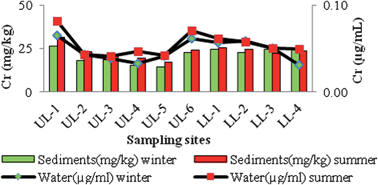Dynamics of toxic heavy metals in different compartments of a highly urbanized closed aquatic system
Abstract
This paper deals with the dynamics of chromium, nickel, copper and lead among the different components namely

* Corresponding authors
a
Analytical Chemistry Laboratory, Department of Chemistry, Indian Institute of Technology Roorkee, Roorkee, Uttarakhand, India
E-mail:
dr.binagupta@gmail.com
Fax: +91-1332-273560
Tel: +91-1332-285326
b Division of Environmental Sciences, Indian Agricultural Research Institute (IARI), New Delhi, India
This paper deals with the dynamics of chromium, nickel, copper and lead among the different components namely

 Please wait while we load your content...
Something went wrong. Try again?
Please wait while we load your content...
Something went wrong. Try again?
B. Gupta, R. Kumar, M. Rani and T. Agarwal, J. Environ. Monit., 2012, 14, 916 DOI: 10.1039/C2EM10505E
To request permission to reproduce material from this article, please go to the Copyright Clearance Center request page.
If you are an author contributing to an RSC publication, you do not need to request permission provided correct acknowledgement is given.
If you are the author of this article, you do not need to request permission to reproduce figures and diagrams provided correct acknowledgement is given. If you want to reproduce the whole article in a third-party publication (excluding your thesis/dissertation for which permission is not required) please go to the Copyright Clearance Center request page.
Read more about how to correctly acknowledge RSC content.
 Fetching data from CrossRef.
Fetching data from CrossRef.
This may take some time to load.
Loading related content
